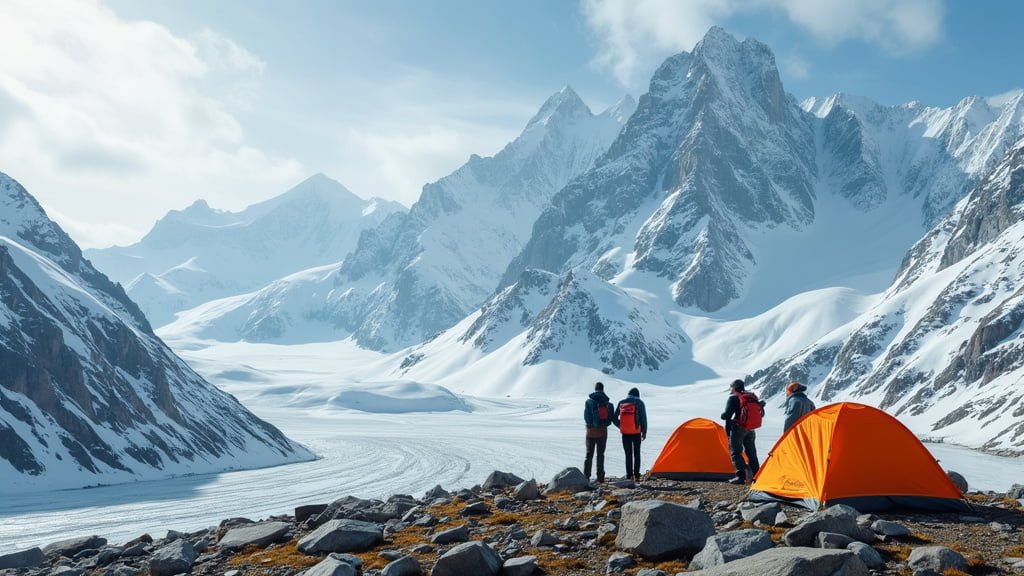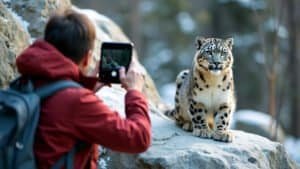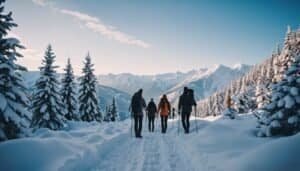Introduction
Developing sustainable tourism around snow leopards presents both opportunities and challenges. Snow leopard tourism can support local economies and raise awareness about conservation, but it also risks disturbing fragile ecosystems and wildlife behavior
This article will explore the environmental impacts of snow leopard tourism, its economic and social challenges, and the logistical issues involved in developing tourism infrastructure in remote habitats
We will also examine how tourism can balance conservation goals with growing visitor demand while ensuring the long-term protection of snow leopards and their ecosystems
Environmental Impacts of Snow Leopard Tourism
The development of snow leopard tourism can have significant environmental consequences, particularly when not managed sustainably. Snow leopards inhabit remote, fragile ecosystems, and the introduction of human activity, even in the form of eco-tourism, can disrupt the natural balance
The challenge lies in minimizing the ecological footprint of tourism while ensuring that snow leopards and other wildlife remain undisturbed in their natural habitats
Effective management and planning are crucial to ensuring that snow leopard tourism supports conservation efforts rather than inadvertently harming the species or its environment
Effects of Human Presence on Snow Leopard Behavior
Snow leopards are elusive, solitary creatures that thrive in remote, undisturbed environments. The increased presence of tourists, even in small numbers, can impact their behavior, causing changes in movement patterns and hunting habits
Studies show that wildlife, including snow leopards, often alter their activity to avoid human contact, becoming more nocturnal or retreating to less accessible areas to evade detection. This shift in behavior can have long-term consequences, as it may affect the leopards’ ability to hunt and secure food, leading to increased stress and potential declines in population health
Research from the Snow Leopard Trust and other wildlife organizations has revealed that excessive human presence can reduce snow leopard sightings in certain areas, suggesting that the animals may actively avoid regions frequented by tourists
This not only diminishes the experience for visitors hoping to catch a glimpse of the animal but also raises concerns about how tourism could push snow leopards further into the wild, away from their optimal habitats
Ecosystem Disruption and Habitat Degradation
In addition to affecting snow leopard behavior, tourism can disrupt the delicate ecosystems in which these animals live. Snow leopards inhabit high-altitude regions like the Himalayas, Central Asia, and parts of Siberia, which are particularly sensitive to environmental changes
Tourism-related activities such as trekking, off-road driving, and camping can lead to soil erosion, degradation of vegetation, and disturbance to prey species like ibex and blue sheep, which are critical to the snow leopard’s diet
Furthermore, the construction of tourism infrastructure—such as lodges, viewing platforms, and roads—can fragment habitats and lead to the displacement of wildlife
Fragmentation makes it more difficult for snow leopards to find prey and suitable mating areas, reducing their chances of survival. In fragile mountain ecosystems, even small-scale disturbances can have cascading effects on biodiversity and habitat health
Waste Management and Pollution in Remote Regions
Tourism in remote snow leopard habitats presents unique challenges when it comes to managing waste and pollution. Without proper infrastructure for waste disposal, the influx of visitors can lead to the accumulation of garbage, which threatens both wildlife and the environment
Plastics and other forms of non-biodegradable waste can enter ecosystems, harming animals and degrading the pristine landscapes that tourists come to see. Additionally, pollution from vehicles, generators, and other tourism-related activities can affect air and water quality, further degrading these sensitive environments
In many remote snow leopard habitats, local communities lack the resources to manage large volumes of waste or implement sustainable waste disposal systems
This can lead to the buildup of refuse in areas frequented by tourists, damaging the natural environment and potentially driving snow leopards and other wildlife away from their traditional ranges
Effective waste management practices, including the reduction of single-use plastics, the establishment of waste collection points, and the education of tourists on responsible behavior, are essential for minimizing the environmental footprint of snow leopard tourism
Economic and Social Challenges
While snow leopard tourism can bring much-needed economic benefits to remote regions, it also introduces significant social challenges
Ensuring that tourism is both economically sustainable and socially equitable is key to developing a model that benefits local communities while conserving snow leopards and their habitats
Balancing economic growth with environmental protection and managing the social impacts of tourism requires careful planning and engagement with local populations
Economic Benefits for Local Communities
One of the main advantages of snow leopard tourism is its potential to provide a stable income for local communities that live in proximity to snow leopard habitats. These regions, often located in remote and economically disadvantaged areas, can benefit from the influx of tourists seeking to catch a glimpse of the elusive big cat
Tourism can create jobs in hospitality, guiding, transportation, and local crafts, which boosts the local economy and improves the livelihoods of those who participate in the tourism industry
For example, in areas like Ladakh in northern India and parts of Nepal, where snow leopard tourism has been introduced, local communities have established eco-lodges, guided tours, and handicraft shops catering to tourists. These initiatives not only create direct employment but also encourage community involvement in conservation efforts
By linking the financial success of the community to the presence of snow leopards, tourism can act as an incentive for local populations to protect these animals rather than view them as threats to their livestock and livelihoods
However, these economic benefits are not always evenly distributed, and many tourism models struggle with ensuring that profits reach the people most affected by snow leopard conservation
Large external operators often dominate the tourism industry, which can lead to a concentration of wealth in the hands of a few rather than a broad economic uplift for the entire community
Social Impacts and Cultural Considerations
The introduction of tourism to remote snow leopard habitats can have profound social impacts on the communities that reside there. While tourism can provide economic opportunities, it can also lead to the erosion of traditional lifestyles and cultural practices
In some cases, the sudden influx of tourists may result in the commercialization of local culture, with communities modifying their customs or traditions to cater to visitor expectations
Additionally, tourism can sometimes create social tensions within communities. Those directly involved in tourism, such as guides, lodge owners, and tour operators, may reap significant financial rewards, while others who do not participate in the industry may feel left out or displaced
This imbalance can lead to friction, especially if the benefits of tourism are perceived to be concentrated among a few individuals or families. Moreover, the influence of foreign tourists can sometimes conflict with the traditional values of these communities, leading to shifts in social dynamics
Cultural respect is a critical aspect of sustainable tourism. It is essential that tourism models work closely with local populations, ensuring that their cultural practices are preserved and that they are consulted throughout the development process
Integrating traditional knowledge and practices into the tourism experience not only enriches the visitor experience but also helps maintain the cultural integrity of the host communities
Balancing Economic Growth with Environmental Protection
One of the most significant challenges in developing snow leopard tourism is balancing the need for economic growth with the imperative of environmental conservation
While tourism can provide financial incentives for protecting snow leopards and their habitats, it can also create pressure on the very ecosystems that support these animals. As tourist numbers increase, the risk of over-tourism becomes a reality, with fragile environments unable to cope with large numbers of visitors
Tourism infrastructure, such as roads, lodges, and viewing platforms, can disturb natural habitats and lead to habitat fragmentation
Additionally, the introduction of more people into snow leopard areas can increase human-wildlife conflicts, particularly if tourists inadvertently disturb snow leopards or their prey. Ensuring that tourism is managed in an environmentally sustainable way is critical for the long-term success of these programs
To strike a balance, tourism models must adopt a “low impact, high value” approach, focusing on attracting fewer but higher-paying visitors. This approach ensures that economic benefits are still generated, while reducing the strain on the environment
Involving local communities in decision-making and ensuring that a portion of the tourism revenue is reinvested into conservation efforts is essential for maintaining the delicate balance between economic development and environmental protection
Infrastructure and Logistical Issues
Developing sustainable snow leopard tourism in remote, high-altitude regions presents a range of infrastructure and logistical challenges. These areas often have limited access, fragile ecosystems, and a lack of basic amenities
Creating the necessary infrastructure for tourism while minimizing its environmental impact is a delicate task that requires careful planning
Additionally, managing the flow of tourists in such remote locations involves logistical hurdles that can make sustainable tourism development difficult
Developing Infrastructure in Remote Areas
Snow leopards live in some of the most inaccessible regions in the world, such as the Himalayas, Altai Mountains, and the Tibetan Plateau. These areas are characterized by harsh climates, high altitudes, and difficult terrain, making infrastructure development both expensive and challenging
For sustainable snow leopard tourism to succeed, basic infrastructure such as accommodations, transportation, and communication systems must be put in place, but in a way that preserves the natural environment
Building eco-friendly infrastructure in these remote regions requires innovative approaches. Traditional hotels or large-scale accommodations can be damaging to the environment, contributing to habitat fragmentation and increased human presence
Instead, eco-lodges and small, locally run accommodations have been promoted as a more sustainable solution. These structures are often built using locally sourced materials and designed to blend into the environment, reducing their ecological footprint
However, developing even small-scale infrastructure in such regions is often costly and logistically complex. Limited access to electricity, clean water, and waste disposal systems further complicates the situation, requiring tourism operators to adopt off-grid solutions like solar power, rainwater harvesting, and composting toilets to minimize their environmental impact
Balancing the need for visitor comfort with sustainability is a constant challenge in remote snow leopard habitats
Impact of Tourism Infrastructure on the Environment
The construction and expansion of tourism infrastructure can have lasting impacts on snow leopard habitats. Roads, campsites, and lodges can fragment habitats, disrupt wildlife movement, and lead to soil erosion
In some cases, infrastructure development can also introduce invasive species or increase human-wildlife interactions, both of which can negatively affect local ecosystems
The increase in vehicular traffic associated with tourism is another concern. Snow leopard habitats are often located in remote, pristine areas with little human disturbance. The introduction of cars, trucks, and buses to transport tourists can cause pollution, disturb wildlife, and accelerate the degradation of landscapes
For example, excessive road construction can cut through key wildlife corridors, making it harder for snow leopards to access prey or mate, thereby threatening their long-term survival
Minimizing the environmental impact of tourism infrastructure requires strict regulations and careful planning. Sustainable tourism models often promote the use of trekking, horseback riding, or other low-impact methods of transportation to reduce the need for roads and vehicles in sensitive areas
In some regions, authorities have restricted vehicle access to certain areas, allowing only eco-friendly transportation options like electric vehicles or bicycles
Challenges of Accessibility and Transport
Accessibility is one of the primary logistical challenges in developing snow leopard tourism. Many of the regions where snow leopards are found are not easily accessible by road or air
In countries like Nepal, India, and Mongolia, reaching snow leopard habitats often requires several days of trekking through rugged terrain, which limits the number of tourists who are physically capable of visiting these areas. While this can be seen as a way to naturally limit the environmental impact of tourism, it also makes it difficult to generate significant revenue from tourism activities
The difficulty in accessing snow leopard habitats also increases the cost and complexity of transporting goods and building materials. Local communities often lack the infrastructure needed to support large-scale tourism, which can hinder the development of sustainable tourism ventures
Air transport, while more efficient, is costly and environmentally damaging due to the high carbon emissions associated with flights to remote areas
To address these challenges, tourism operators and conservationists are working to develop innovative solutions, such as using pack animals, like yaks or donkeys, to transport materials and supplies in an eco-friendly way
Additionally, there are ongoing efforts to improve communication and navigation systems, which can enhance the safety and experience of tourists while minimizing the need for invasive infrastructure
Balancing Conservation with Tourism Growth
A major challenge in developing snow leopard tourism is finding the right balance between promoting tourism and ensuring the long-term conservation of snow leopards and their habitats
Tourism can provide financial support for conservation efforts, but if poorly managed, it can also lead to environmental degradation and increased pressure on the species it aims to protect
Achieving a sustainable model of tourism growth requires careful planning and ongoing management to ensure that the ecological integrity of snow leopard habitats is maintained while still allowing for economic benefits
Limiting Visitor Numbers to Protect Ecosystems
One of the most effective strategies for managing the environmental impact of snow leopard tourism is to limit the number of visitors to key habitats. Snow leopards are highly sensitive to disturbances, and even small increases in human presence can disrupt their behavior and cause stress
By capping the number of tourists allowed into certain areas, conservationists can help reduce the negative impacts of tourism while maintaining the natural behavior of snow leopards and other wildlife
Implementing visitor limits requires a system of permits or quotas, where a limited number of tourists are allowed to visit snow leopard habitats during a specific time period
This strategy has been successfully used in other wildlife tourism sectors, such as gorilla trekking in Rwanda, where strict visitor limits have helped protect the animals while generating significant revenue for conservation and local communities
In snow leopard tourism, setting visitor limits would need to be accompanied by clear guidelines for ethical wildlife viewing. Tourists must be educated on how to minimize their impact, such as maintaining a safe distance from animals, avoiding making loud noises, and not leaving waste behind
These measures help protect the fragile ecosystems that support snow leopards and ensure that tourism remains a force for good in conservation
Education and Awareness for Tourists
Raising awareness among tourists is crucial for the success of sustainable snow leopard tourism. Visitors often have little knowledge of the delicate balance required to protect snow leopards and their habitats
By educating tourists about the conservation challenges snow leopards face, as well as the role they can play in supporting these efforts, tourism operators can create a more responsible and informed visitor experience
Educational programs can be integrated into the tourism experience through guided tours, visitor centers, or informational materials provided before and during trips
Tourists can learn about the ecological significance of snow leopards, the threats they face, and the importance of maintaining a healthy environment for their survival. When tourists understand the conservation goals behind their experience, they are more likely to respect wildlife and contribute to conservation efforts
Some snow leopard tourism programs already incorporate these educational aspects. For example, in the Hemis National Park of Ladakh, India, tourists are given detailed briefings on snow leopard behavior, conservation strategies, and the role of local communities in protecting these animals
These programs foster a sense of responsibility and stewardship among visitors, encouraging them to support snow leopard conservation efforts beyond their trip
Sustainable Tourism Models for Snow Leopard Habitats
To ensure the long-term sustainability of snow leopard tourism, it is essential to adopt tourism models that prioritize conservation while also providing economic benefits
One effective approach is community-based tourism, where local communities are directly involved in the management and operation of tourism activities. This model not only ensures that tourism revenue is distributed equitably but also gives local populations a vested interest in protecting the environment and wildlife
In many snow leopard regions, local communities are already playing a crucial role in conservation. For example, in Kyrgyzstan, a community-based tourism project called “Snow Leopard Enterprises” involves local herders in eco-tourism activities such as guiding and hosting tourists
The revenue generated from these activities provides a direct financial incentive for communities to protect snow leopards, as they benefit from the continued presence of wildlife
Sustainable tourism models also emphasize low-impact practices, such as limiting the size of tourist groups, using eco-friendly accommodations, and promoting non-invasive wildlife viewing techniques
These models aim to reduce the ecological footprint of tourism while ensuring that the financial benefits are shared by both conservation efforts and local communities. By integrating these principles, snow leopard tourism can grow in a way that supports both the environment and the economy
Conclusion
Developing sustainable snow leopard tourism presents both significant opportunities and formidable challenges. On the one hand, tourism can generate vital economic benefits for remote communities, provide funding for conservation, and raise global awareness about the importance of protecting snow leopards and their habitats
On the other hand, without careful management, tourism can lead to environmental degradation, disrupt the behavior of snow leopards, and place undue pressure on the fragile ecosystems they inhabit
Key challenges include mitigating the environmental impacts of human presence, ensuring equitable economic benefits for local communities, and overcoming logistical hurdles in developing infrastructure in remote and inaccessible areas
Furthermore, finding a balance between tourism growth and conservation requires implementing measures such as limiting visitor numbers, educating tourists, and promoting community-based tourism models that prioritize both conservation and local livelihoods
By addressing these challenges head-on with innovative and sustainable solutions, snow leopard tourism can become a powerful tool in conservation efforts. A carefully planned and managed approach will ensure that tourism contributes to the long-term survival of snow leopards while also benefiting the communities that share their habitat










